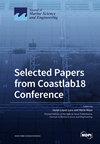CFD 驱动的船舶修整优化:集成 ANN 以开发用户友好型软件工具
IF 2.7
3区 地球科学
Q1 ENGINEERING, MARINE
引用次数: 0
摘要
本研究提出了一种全面的修整优化方法,作为一种提高能效的措施,重点是降低一艘滚装船的油耗。该方法利用计算流体动力学(CFD)软件,结合人工神经网络(ANN)开发了一个数学模型,用于估算制动功率、日耗油量(DFOC)和螺旋桨转速等关键参数。然后将复杂的人工神经网络模型集成到用户友好型软件工具中,用于实际工程应用。研究概述了七阶段修整优化过程,并讨论了将其扩展到其他类型船舶的可能性,旨在为基于 CFD 的工程分析建立一种通用方法。根据修剪优化结果,在吃水 7.5 米的情况下,最大 DFOC 可达到 10.5%,而在吃水更高的情况下,最大 DFOC 可达到 8%。一般来说,在考虑到的每种情况下,都建议在航行时将修剪朝向船首,这意味着船舶的纵向重心应调整为略微前倾。本文章由计算机程序翻译,如有差异,请以英文原文为准。
CFD-Powered Ship Trim Optimization: Integrating ANN for User-Friendly Software Tool Development
This study presents a comprehensive approach to trim optimization as an energy efficiency improvement measure, focusing on reducing fuel consumption for one RO-RO car carrier. Utilizing Computational Fluid Dynamics (CFD) software, the methodology incorporates artificial neural networks (ANNs) to develop a mathematical model for estimating key parameters such as the brake power, daily fuel oil consumption (DFOC) and propeller speed. The complex ANN model is then integrated into a user-friendly software tool for practical engineering applications. The research outlines a seven-phase trim optimization process and discusses its potential extension to other types of ships, aiming to establish a universal methodology for CFD-based engineering analyses. Based on the trim optimization results, the biggest DFOC goes up to 10.5% at 7.5 m draft and up to 8% for higher drafts. Generally, in every considered case, it is recommended to sail with the trim towards the bow, meaning that the ship’s longitudinal center of gravity should be adjusted to tilt slightly forward.
求助全文
通过发布文献求助,成功后即可免费获取论文全文。
去求助
来源期刊

Journal of Marine Science and Engineering
Engineering-Ocean Engineering
CiteScore
4.40
自引率
20.70%
发文量
1640
审稿时长
18.09 days
期刊介绍:
Journal of Marine Science and Engineering (JMSE; ISSN 2077-1312) is an international, peer-reviewed open access journal which provides an advanced forum for studies related to marine science and engineering. It publishes reviews, research papers and communications. Our aim is to encourage scientists to publish their experimental and theoretical results in as much detail as possible. There is no restriction on the length of the papers. The full experimental details must be provided so that the results can be reproduced. Electronic files and software regarding the full details of the calculation or experimental procedure, if unable to be published in a normal way, can be deposited as supplementary electronic material.
 求助内容:
求助内容: 应助结果提醒方式:
应助结果提醒方式:


